La Gomera, the magical island
Over 50 ravines cut through the green island
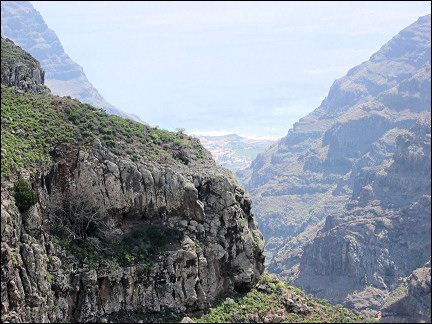
|
La Gomera is an oasis of quiet in stunning natural surroundings. No mass tourism here, no high-rise buildings. Small villages with easy-going inhabitants, potters, fishermen and banana growers. Beautiful views of the ocean, terraced hillsides, mountains and ravines cutting through them. At the center of the island is an ancient, foggy rainforest. La Gomera is a magical island, perfect for hiking.
Travelogue & photos: Luk Carion
La Gomera, with its 378 km² the second smallest island (El Hierro is even smaller) of the Canary Islands, lies at 35 km south-west of Tenerife and less than 150 km off the African coast. With the fast ferry from Los Christianos it takes an hour to get from Tenerife to La Gomera.
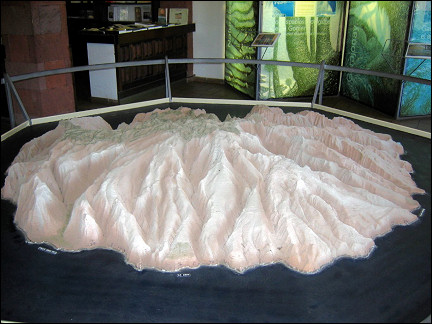
|
The sun shines bright, the ocean is calm. In the distance behind me I see Teide, with its 3718 meters the highest mountain of Tenerife and also of Spain in general. Ahead of us, we approach La Gomera. The island is like a cone which rests on the ocean floor, with at the top the old, no longer active, volcano Garajonay with its peak at 1487 m.
From that peak, over 50 ravines (barrancos) cut through the island, each of them flowing out in the Atlantic Ocean.
La Gomera is overgrown with lush green palmtrees and a rainforest of bay trees. There are small villages, black beaches, clear water and the air is clean. It's an oasis for busy people who want more than sun and sea.
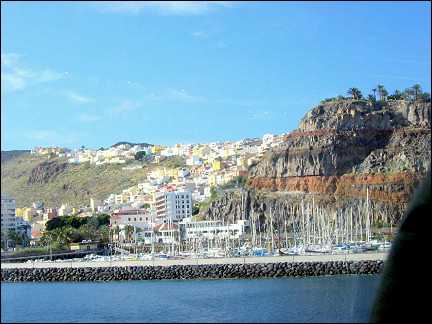
|
The fast ferry docks in San Sebastián de La Gomera, the capital of the island and also its main port. Christopher Columbus docked here to stock up on freshwater, firewood, meat and live stock, and to pray for a successful journey.
La Gomera isn't called "Isla Colombina" for nothing. Here Columbus found the favorable trade winds that would take him all the way to the New World in the unknow far west.
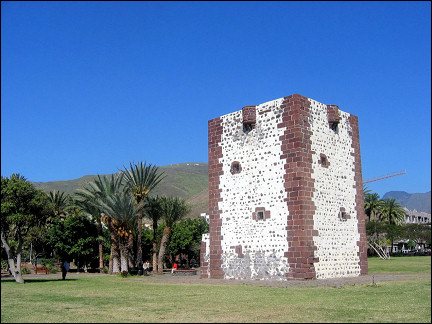
|
Only a few memorials remind of those days: the main one is the Torre del Conde, built in 1449. This defense tower was originally meant to beat off attacks by the inhabitants of the island, later also to defend the island against hostile pirates.
San Sebastián, in the past the most important transit port to the new world, currently has around 8000 inhabitants. A little more than the rest of the island. It's pleasantly busy: shops, bars and restaurants; the Spanish chatter around me brings me in the mood. Remarkable is the number of exotic-looking bars; later on, I'll find out that many people from the island emigrated to Latin America.
Playa de Santiago
Mountainous but green and mainly deserted and desolate
We drive our rental car to Playa de Santiago. This first drive gives a good impression of the island: mountainous but green, great views of the ocean and mainly deserted and desolate. No tourism, certainly no mass tourism, only small hamlets; few houses along the road.
The road is in good condition, but requires good steering skills when entering and leaving the barrancos: what looks like a few kilometers on the map, in bird's- eye view, is in reality a great number of winding kilometers.
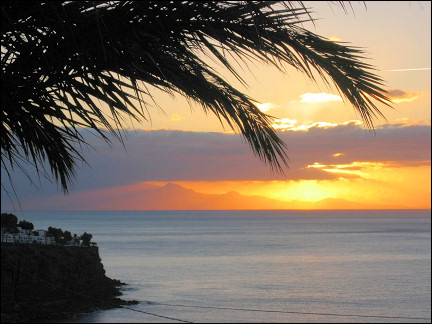
|
We arrive in Playa de Santiago, I'm tired. On the terrace of our apartment, on a cliff above the town, I sit down in a chair. In my view is a palmtree in the setting sun. In the distance I can still see Tenerife with the peak of the Teide. It's still warm, and the sound of crickets and a glass of white wine make me doze off. I sense that this is going to be a great trip.
When I wake up next morning, I hear the engines of the Garajonay Express, a ferry service which connects different parts of the island. It's quick and cheap. It's time for a first exploration of the island.
Barranco de Benchijigua
Sub-tropical paradise with flowers, cactuses and palm trees
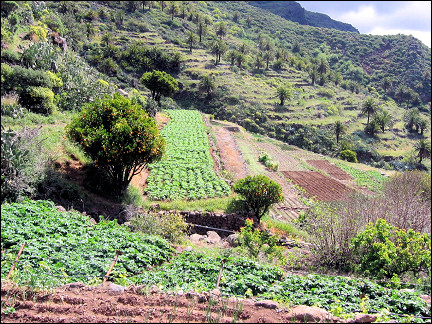
|
The hike to the Barranco de Benchijigua leads through an almost subtropical paradise with flowers in all colors, cactuses, palm trees and shrubs. The paved, walled-in path first goes along terraces. Here and there are farm houses of the farmers who cultivate these terraces, now mainly planted with potatoes.
Time has stood still here. The yield of the crops is minimal, because the terraces require intensive manual labor: agricultural machines can't be used on these narrow terraces. The produce is mainly used to feed the farmers' families; some of it is sold in local stores.
The path gets rougher: a few goats and donkeys roam an arid meadow, there are also some chickens there. It's clear we're walking on a centuries-old path. There are many like this on La Gomera: they were constructed for goat herds, pilgrims, lumberjacks and merchants. Now they open up the ravines for hikers. Good shoes are necessary, because the path is strewn with stones, which makes walking difficult, one has to be careful at all times.
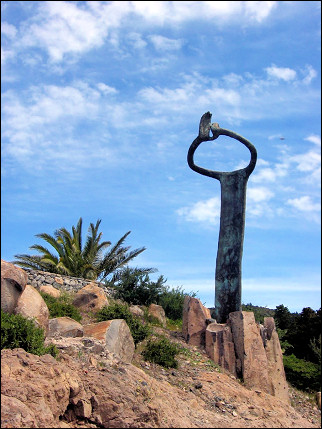
|
A loud and sharp whistling draws my attention. It's Silbo Gomero, the language of the original population of the island. This whistle language consists of six different whistle tones. Because of the deep barrancos (long descent, followed by serious climb), this language was very useful to exchange messages over a long distance.
Silbo was at risk to become extinct during the 20th century, so it was made part of the school curriculum on La Gomera. On the road from Playa de Santiago to El Cercado, at a great lookout spot, is a sculpture in honor of this whistle language.
The path leads farther up, along water pipes and reservoirs. They irrigate the terraces with water from the high "magical" mountain Garajonay. We see a lot of palm trees, with many cactuses in their shade.
We return, the path is - like many on La Gomera - badly indicated and we have to watch out for rocks, the temptation to look instead at views of the barrancos is strong.
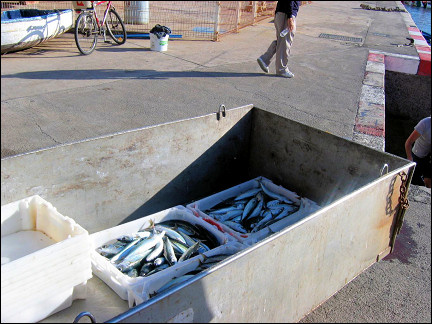
|
Playa de Santiago is described as an important tourist resort, but it's still a village. We stay in a small-scale apartment building on a cliff. There are no high-rise buildings here, but there are two large hotel resorts nearby. The small port town doesn't feel touristic at all: one sees and hears only the local population.
They sit chatting in the three outdoor cafés, but mainly on the central square. Two stores supply the locals (and us) with groceries, and there is a candy stall which is open all day. A few fisher boats are docked, every now and then a boat returns with its catch of the day.
The atmosphere is quiet and relaxed. From the pier I see the Garajonay Express arrive and leave again. The beach (basalt-black) is sparsely visited.
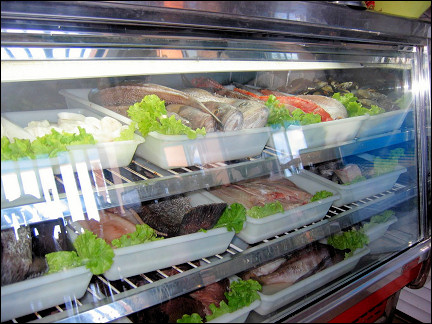
|
A few restaurants look a little more touristic: a reason why we will visit small villages in the area to eat well and to taste the local cuisine (goat meat and watercress soup).
Alajeró
Looking for a 300-year-old dracaena
We drive from Playa de Santiago toward Alajeró, at 800 m in a barranco on the south coast. The original population has emigrated to Latin-America. Now we understand why there are so many Latin-American looking bars in the island's capital.
The village on the slope of the barranco has been beautifully restored. Many houses are now rented to tourists. Along a narrow path we descend into the ravine, looking for a 300-year-old dracaena. The path leads along Indian fig opuntias and palm trees. To the right is a pretty valley, overgrown with palm trees.
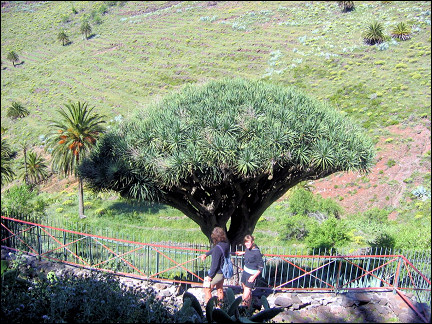
|
Eventually we find the "Drago," protected by an iron fence. The circumstances that allow this tree to get this old have to be exceptional: temperature, humidity, precipitation, heat. Even so, this dracaena is a dwarf compared to the one on Tenerife, which is 700 years old.
The dracaena was important in the lives of the Guanchen, the original population of the Canary Islands in the ancient past. Its main produce was "dragon blood," which was used as a medicine.
We climb back to Alajeró, to continue our trip to the chapel of Saint Isidore. The chapel was built on a high hill and can be seen from miles away. Its location has a wonderful view of the south coast of La Gomera. We sit down on rocks, which lie scattered around and enjoy the sun and the view.
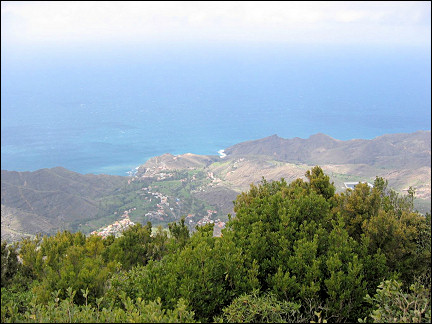
|
We return and continue our hike to Targa, an idyllic authentic village, beautifully located on a barranco. We quench our thirst in the only café, opposite the small school building. The local people are chatting, a van - which turns out to be a mobile store - stops at several houses.
We stroll through the village. The pace of life here is relaxed and slow. On the terraces an elderly man is watering potatoes with an irrigation system, children play outside, while mothers are busy in kitchens, loudly banging pots and pans. A few chickens roam along the road.
This is a different world, with different values and norms; no great riches for these people, surviving is difficult enough as it is, but everything seems simpler, more transparant and enjoyable than in our own country.
El Cercado
All pottery is hand-turned
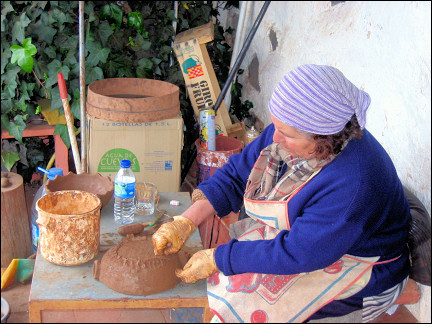
|
El Cercado is embedded in a pretty terrace landscape on the higher hills at the center of La Gomera. El Cercado has been a pottery village since time immemorial. It still is, and the tradition is transferred from one generation to the next.
Remarkable is that they don't use a potter's wheel, but turn vases, mugs and bowls by hand, using local red clay, after which the objects are baked in a stone woodfire oven. Inside, in the store, local produce is for sale, like honey and olive oil. Outside, the women are busy making pots and vases. Their faces are sun-beaten.
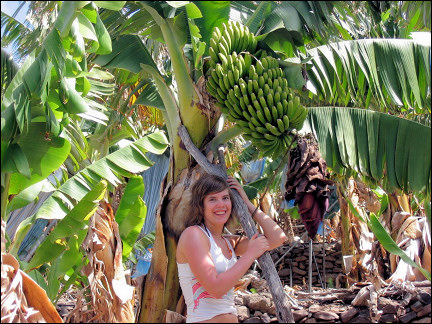
|
On the way to the Valle Gran Rey on the westside of the island, we take a short walk via La Dama. Here are the largest banana plantations of La Gomera. The intensively irrigated plantations yield the so-called Canary banana: tasty and smaller than the one we find in stores at home.
Competition makes life hard for the farmers here: despite EU support, these bananas are only sold here and in Spain. There are many experiments with other crops: pineapple and avocado.
Valle Gran Rey
Los Organos, basalt formations in the shape of organ pipes
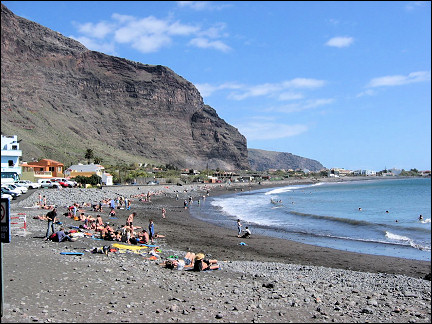
|
Valle Gran Rey, which used to be a meeting point and vacation destination for hippies, is a very touristy village, even though that is relative: no high-rise buildings, a small village center, a port and a beach.
It lies, sheltered by high hills, in a bay with many palm trees and flower gardens. From here one can take a half-day trip on the ocean in an old fisher boat, converted to tourist boat. We take the trip, which will take us to the west and north of the island.
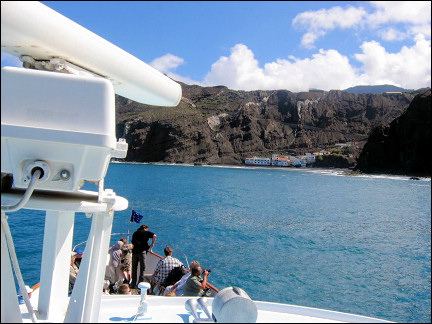
|
We sit on the small deck. The wind is refreshing and the sun shines like it does every day. From the sea one has a different perpective of the island. The barrancos are more clearly visible, just like the cliffs which one hardly sees from the land.
The sea smells good: the air qualitly on the Canary Islands is among the best in the world.
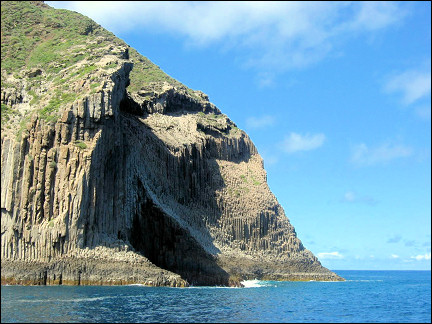
|
Our destination is "Los Organos," one of the most beautiful basalt formations on the Canary Islands. The stone pillars, shaped like organ pipes, are leftovers from wide lava streams after an eruption of the volcano. Erosion made it into a natural work of art.
We get an hors d'oeuvre: tasty tuna, fried on the boat. Sea air makes hungry, doesn't it?
National Park Garajonay
Ferns, creepers, and bay trees in a foggy rainforest
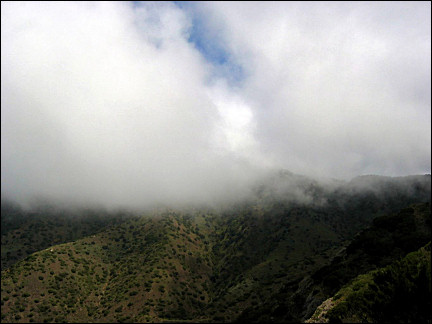
|
La Gomera's central mountain massif with its highest peak Garajonay (1490 m), National Park Garajonay, has been declared World Natural Heritage by the UNESCO. It covers about 10 percent of La Gomera and consists mainly of foggy rainforest.
There are many hiking trails in the park. Hiking in the centuries-old forest means one has to take into account the weather. Out of nowhere fog appears, which lowers the temperature drastically.
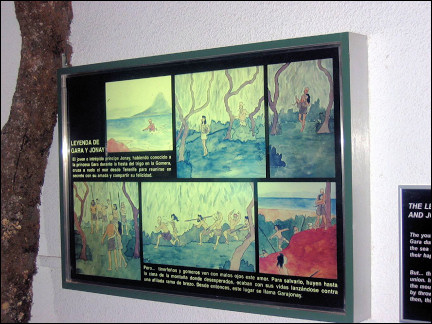
|
The name Garajonay was taken from an old myth about Gara and Jonay. Gara lived on Tenerife and fell in love with the poor Gomeran farmer's son Jonay. He loved her too and often swam to the neighboring island to visit his love. A priest predicted terrible unhappiness for them. At the time of the wedding Tenerife was struck by a heavy earthquake; the Teide spit burning lava, the sea around La Gomera colored red and the island was scorched. Relatives tried to stop the wedding, but their love was so strong that they fled up the mountains, into the woods, to the highest spot on the island. Neither of them knew what to do. So they took a spear with two spearheads and drove it simultaneously through both of their hearts and died.
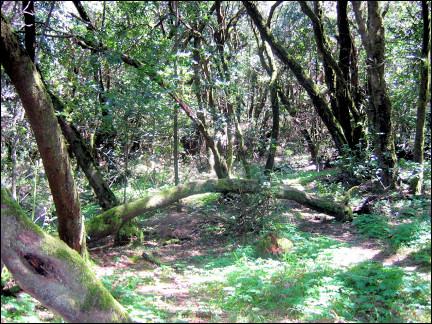
|
The climb to the top of the Garajonay is worth the trouble. One is rewarded with great views, at least if there's no fog. The Alto de Garajonay has many hiking trails to take and explore the rainforest.
Its ferns, creepers and bay trees are in strong contrast with the the rest of the island. At the visitors center in Agulo, "Juego de Bolas," we find more information about this centuries-old forest, and also about the habits of its inhabitants, now and in the past. Its garden offers a nice sample of tropical plants, which florish here in the sun.
Vallehermosa
The surf can be wild here
Our route continues to Vallehermosa at the north side of the central massif, in the past the economic and cultural center of La Gomera. It's not so busy anymore, but the banana plantations and other agricultural companies are still there. Most houses are whitewashed. In the distance we see the ocean.
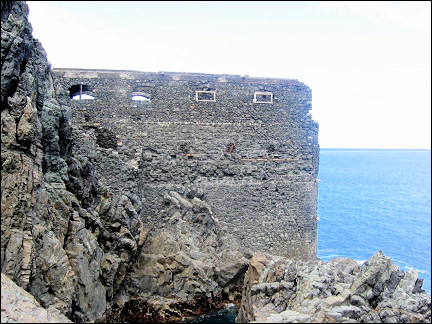
|
Because the surf can be dangerous here, a swimming pool was built. We have a tasty lunch on the terrace of a small restaurant. The sound of the strong surf, the sun and the organ pipes nearby make us feel relaxed. In the distance we see La Palma, on of the other Canary Islands.
Again we notice how calm people here are. The wonderful landscape with steep barrancos, leading from the mountains to the sea, was not the only thing that struck me on La Gomera. The people who live here moved me. They live by the day, even though they are well aware of what's going on in the world, but they have an inner peace like I've hardly seen before. The pace of everything makes them seem to float with every step they take. They won't let themselves be driven crazy, but still do the things that have to be done. The differenc between their pace of life and ours: we still have a lot to learn...
On the way back we again take the Fred Olsen fast ferry; behind us, La Gomera gets smaller and smaller. We remember Gara and Jonay. Along the stem of the ship, Tenerife gets closer. On arrival, a true culture shock awaits us: the noisy streets of Los Christianos, the many stores and loud restaurants, we're no longer used to that. Also the beach, paved with hundreds of deck chairs, does not appeal to us.
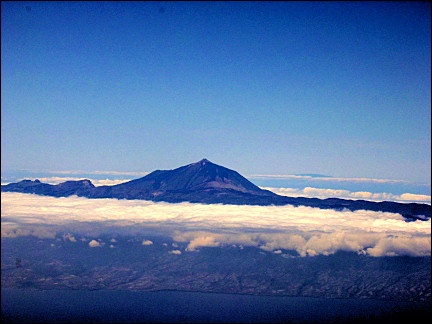
|
We take a cab to Tenerife Sur and from the plane we see Teid appear above the clouds, a mountain with a centuries-old history and stories, with in its shadow La Gomera, where we definitely will return some time.